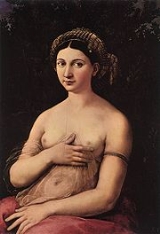
La Fornarina
Encyclopedia
The Portrait of a Young Woman (also known as La fornarina) is a painting by the Italian
High Renaissance
master Raphael
, made between 1518 and 1520. It is in the Galleria Nazionale d'Arte Antica
in Palazzo Barberini
, Rome
.
It is probable that the picture was in the painter's studio at his death in 1520, and that it was modified and then sold by his assistant Giulio Romano
http://www.galleriaborghese.it/barberini/it/fornarin.htm. In the 16th century the picture was in the house of the Countess of Santafiora, a Roman noblewoman, and subsequently became property of the Duke Boncompagni
and then of the Galleria Nazionale which still possesses it.
The woman is traditionally identified with the fornarina (bakeress) Margherita Luti, Raphael's Roman mistress, though this has been questioned. The woman is pictured with an oriental style hat and bare breasts. She is making the gesture to cover her left breast, or to turn it with her hand, and is illuminated by a strong artificial light coming from the external. Her left arm has a narrow band carrying the signature of the artist, RAPHAEL URBINAS. It has been suggested that the right hand on the left breast reveals a cancerous breast tumour disguised in a classic pose of love http://www.thelancet.com/journals/lancet/article/PIIS0140673602119970/fulltext.
X-Ray analyses have shown that in the background was originally a Leonardesque-style
landscape in place of the myrtle bush, which was sacred to Venus
, goddess of love and passion.
Italy
Italy , officially the Italian Republic languages]] under the European Charter for Regional or Minority Languages. In each of these, Italy's official name is as follows:;;;;;;;;), is a unitary parliamentary republic in South-Central Europe. To the north it borders France, Switzerland, Austria and...
High Renaissance
High Renaissance
The expression High Renaissance, in art history, is a periodizing convention used to denote the apogee of the visual arts in the Italian Renaissance...
master Raphael
Raphael
Raffaello Sanzio da Urbino , better known simply as Raphael, was an Italian painter and architect of the High Renaissance. His work is admired for its clarity of form and ease of composition and for its visual achievement of the Neoplatonic ideal of human grandeur...
, made between 1518 and 1520. It is in the Galleria Nazionale d'Arte Antica
Galleria Nazionale d'Arte Antica
The Galleria Nazionale d'Arte Antica, or National Gallery of Ancient Art, is an art gallery in Rome, Italy, located on two sites: the Palazzo Barberini and the Palazzo Corsini....
in Palazzo Barberini
Palazzo Barberini
Palazzo Barberini is a palace in Rome, facing the piazza of the same name in Rione Trevi and is home to the Galleria Nazionale d'Arte Antica.-History:...
, Rome
Rome
Rome is the capital of Italy and the country's largest and most populated city and comune, with over 2.7 million residents in . The city is located in the central-western portion of the Italian Peninsula, on the Tiber River within the Lazio region of Italy.Rome's history spans two and a half...
.
It is probable that the picture was in the painter's studio at his death in 1520, and that it was modified and then sold by his assistant Giulio Romano
Giulio Romano
Giulio Romano was an Italian painter and architect. A pupil of Raphael, his stylistic deviations from high Renaissance classicism help define the 16th-century style known as Mannerism...
http://www.galleriaborghese.it/barberini/it/fornarin.htm. In the 16th century the picture was in the house of the Countess of Santafiora, a Roman noblewoman, and subsequently became property of the Duke Boncompagni
Boncompagni
The Boncompagni is an Italian noble family from Assisi.-History:The family is documented for the first time in 1133, when one Rodolfo Boncompagni, a German nobleman of Saxon origins, was appointed by Lothair II as lord of Assisi...
and then of the Galleria Nazionale which still possesses it.
The woman is traditionally identified with the fornarina (bakeress) Margherita Luti, Raphael's Roman mistress, though this has been questioned. The woman is pictured with an oriental style hat and bare breasts. She is making the gesture to cover her left breast, or to turn it with her hand, and is illuminated by a strong artificial light coming from the external. Her left arm has a narrow band carrying the signature of the artist, RAPHAEL URBINAS. It has been suggested that the right hand on the left breast reveals a cancerous breast tumour disguised in a classic pose of love http://www.thelancet.com/journals/lancet/article/PIIS0140673602119970/fulltext.
X-Ray analyses have shown that in the background was originally a Leonardesque-style
Leonardo da Vinci
Leonardo di ser Piero da Vinci was an Italian Renaissance polymath: painter, sculptor, architect, musician, scientist, mathematician, engineer, inventor, anatomist, geologist, cartographer, botanist and writer whose genius, perhaps more than that of any other figure, epitomized the Renaissance...
landscape in place of the myrtle bush, which was sacred to Venus
Venus (mythology)
Venus is a Roman goddess principally associated with love, beauty, sex,sexual seduction and fertility, who played a key role in many Roman religious festivals and myths...
, goddess of love and passion.

